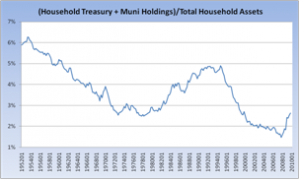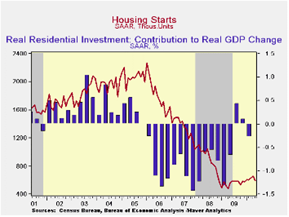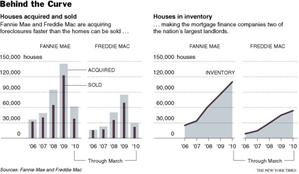The resurgence in risk appetite continued apace this past week, allowing the S&P 500 index and the Dow Jones Industrial Average to return to positive territory on the year. By the end of the week, the S&P was up 2.4% and the DJIA finished up 2.3%.
Yields on US Treasury bonds ended moderately tighter on the week despite the strong performance in risk assets. At the beginning of the year, numerous prognosticators were calling for a surge in Treasury yields, but to the contrary, yields fell from 3.8% at the start of the year to 3.2% this past Friday. The explanation for this move may be simpler than we all realize.
Based on data from the Federal Reserve’s Flow of Funds report, US households are severely underinvested in Treasury and Municipal securities. With more than 50% of household assets tied up in equities and real estate, the recession of 2008/09 seems to have left a mark on many individuals, especially those in the baby boomer generation who are inching ever closer to retirement. This is fueling a reallocation away from equities in favor of bonds and income producing securities.
 This is certainly not a panacea for low interest rates forever, especially considering the uncertainty around China’s future appetite for Treasuries, but it does provide a sorely needed source of financing for the Treasury Department in coming years.
This is certainly not a panacea for low interest rates forever, especially considering the uncertainty around China’s future appetite for Treasuries, but it does provide a sorely needed source of financing for the Treasury Department in coming years.
Housing: with the government gradually removing its chokehold on the housing industry, economists are growing concerned that housing is set to experience a slowdown in the second half of the year.
 As expected, the initial reports surrounding May housing data are weak with housing starts falling 10% due to a 17% drop in single family starts. The weakness in residential investment represented a major drag on GDP from 2006 through the first quarter of 2009, before finally contributing to positive growth in the second half of 2009. Those gains were rather fleeting and housing once again became a net detractor to growth in the most recent quarter.
As expected, the initial reports surrounding May housing data are weak with housing starts falling 10% due to a 17% drop in single family starts. The weakness in residential investment represented a major drag on GDP from 2006 through the first quarter of 2009, before finally contributing to positive growth in the second half of 2009. Those gains were rather fleeting and housing once again became a net detractor to growth in the most recent quarter.
Perhaps more problematic was the news that Fannie Mae and Freddie Mac, the beleaguered US mortgage financing companies, have requested $145bln from government coffers, with one ratings agency suggesting that a $1trln financing package for those two firms is not out of the question.
According to the New York Times, foreclosures forced the two firms to take over ownership of a new home every 90 seconds during the first quarter of this year. By the end of March, the firms owned a combined 163k homes.
 This is actually not as detrimental as it appears on the surface because Fannie and Freddie represented a dwindling slice of the market during the years between 2005 and 2007 and were fortunate to avoid a good portion of the poorly originated loans. However, as we are all acutely aware, the firms are the de facto lender of last resort and by some estimates, account for as much as 97% of the mortgage market.
This is actually not as detrimental as it appears on the surface because Fannie and Freddie represented a dwindling slice of the market during the years between 2005 and 2007 and were fortunate to avoid a good portion of the poorly originated loans. However, as we are all acutely aware, the firms are the de facto lender of last resort and by some estimates, account for as much as 97% of the mortgage market.
Long term, Fannie and Freddie will face years of losses related to sour mortgages, all at the expense of the US taxpayer.
Taxpayers are also on the hook for the current home modification program, which is looking like an unmitigated disaster at this point. The Home Affordable Modification Program (HAMP) was originally designed to provide payment relief for homeowners who were struggling under the burden of debt. Sounds simple enough, but what the government forgot to account for was all the other debts (credit cards, auto loans, student loans, etc) those individuals are carrying.
For the average person, HAMP provides $500 a month in mortgage payment relief. Even accounting for that deduction, 64% of pretax income is spent on debt payments. That is an unserviceable burden and Fitch Ratings estimates that 65% to 75% who enter the HAMP modification process will re-default within 12 months.



